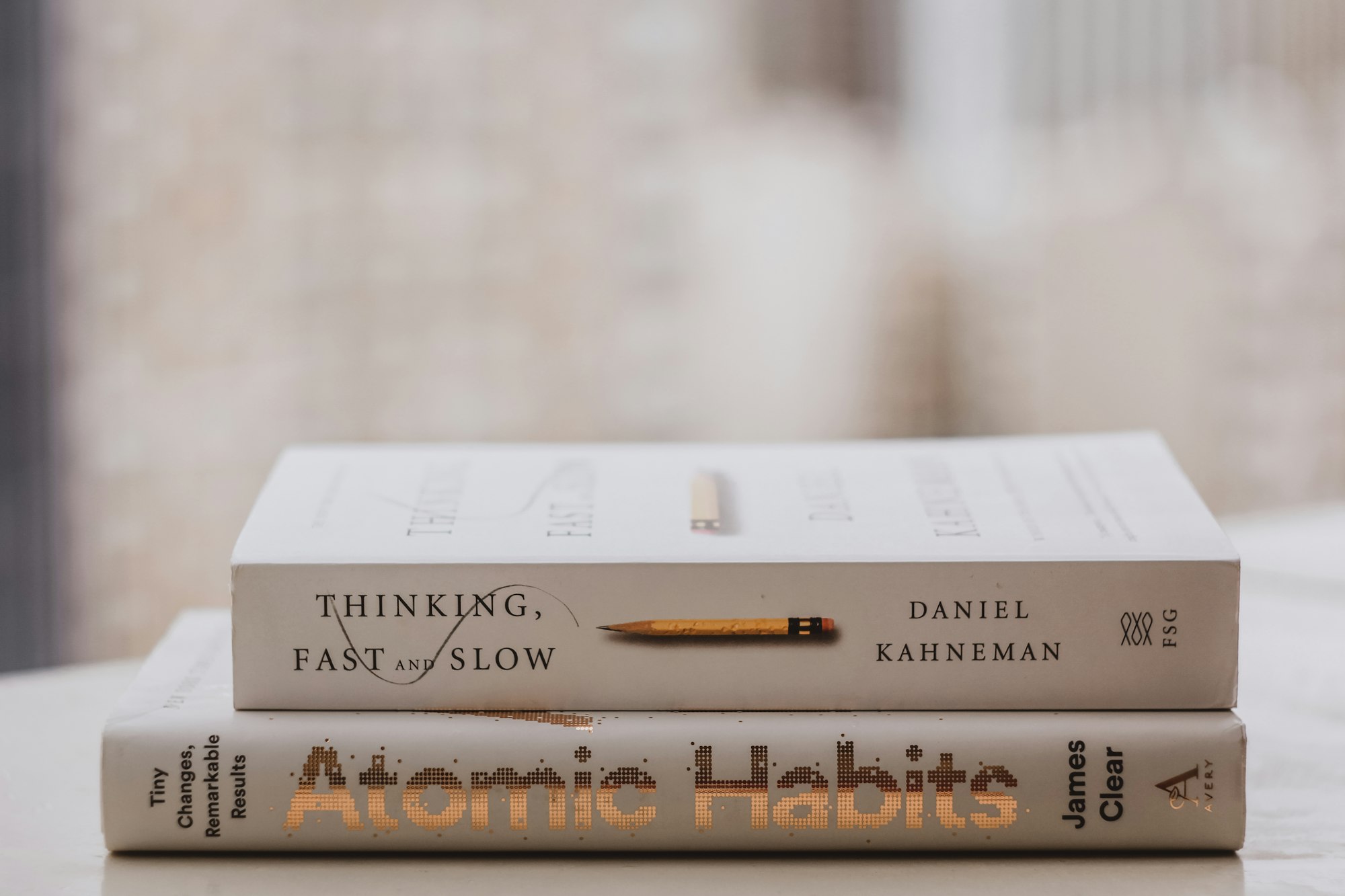There Are No "Bad" Habits
I have never had an audiobook stop me in my tracks and compel me to write down a quote because it resonated with me so much. Atomic Habits did just that.

If you keep up to date with our "Monthly Recap" emails here at RxTeach, you will know that I always list what books I have read or listened to that month.
There has been one book on my "want to read" list for quite sometime. I was finally able to borrow the audiobook version the other day! The book is Atomic Habits by James Clear.
I have never had an audiobook stop me in my tracks and compel me to write down a quote because it resonated with me so much. Atomic Habits did just that. It was at that point, driving into work, that I knew I needed to write an article to share some of these quotes from the book with you.
I first heard about this book through Nick Bare from his podcast. He reads books that focus on leadership, team building, and self improvement. He frequently references the book Atomic Habits, and the lessons he learned from the book. From his passion, I knew I needed to add it to my own list.
Below I will recap some of the highlights that I took away from my first read through (well, listen-through, but you know it is all the same).

You Can Change Your Habits
What is a habit? The exact definition is as follows:
The key here is that our brain is involved. Our brain learns our behaviors and connects responses to them, automatically. Consider this paraphrase from the book:
- If you show a patient who is obese a structured workout schedule and diet plan, you may be thinking you are doing your due diligence as a health care professional. However, they may begin to stress about this information and the gravity of the situation. Instead of hopping on board with your plan, they will go to their coping mechanism which is overeating. This is what their brain has associated with stress: overeating. They automatically turn to this response.
- If you show a smoker a picture of black lungs to "scare" them about the long term consequences of smoking, they will likely become anxious. When they have anxiety, they go to their coping mechanism and begin to crave a cigarette. Thus, continuing their cycle of smoking and counteracting your intent.
Samuel Thomas Davies published a summary on this book, and gave the perfect "three sentence summary" that I have copied below:
- "An atomic habit is a regular practice or routine that is not only small and easy to do but is also the source of incredible power; a component of the system of compound growth."
- "Bad habits repeat themselves again and again not because you don’t want to change, but because you have the wrong system for change."
- "Changes that seem small and unimportant at first will compound into remarkable results if you’re willing to stick with them for years."
Let's apply habit development to your current job. What task do you complete regularly? Verifying orders as a pharmacist? Filling medications for a prescription as a pharmacy technician? Updating progress notes as a medical resident? Think about when you first started this responsibility compared to how you complete the task now. When you first started, you had to really focus on what you were doing. Now, you might be able to quickly complete your required work. Why? Over time, your brain has developed an understanding of your actions. That is because “the behavioral patterns we repeat most often are literally etched into our neural pathways.” Our brains build a habit around the path of least resistance. Here is this concept applied to each of the three job responsibilities listed earlier:
- Pharmacist verifying orders: You see the same drug interaction alert pop-up for albuterol nebulizers and carvedilol tablets. You learn the short cuts for EPIC to verify orders more quickly. Certain order sets are all too common and you become fatigued to the numerous pop-ups about duplicate orders for pain medications. You continue to quickly verify and click past the alerts which can lead to bypassing more important alerts later on in the verification queue.
- Technician filling prescriptions: You have to scan the label and then the medication bottle prior to filling prescriptions. You rely on the barcode scan after awhile and become fatigued when you constantly "count by 5's." This can lead to mis-filling prescriptions with the wrong medication in a fast-passed environment and inaccurate filling if you grab the incorrect bottle after scanning or lose count of your "5's" and do not double check yourself.
- Medical resident updating notes: You become caught up in the tedious task of updating a note every single day on a complicated or long-term patient. It is easy to copy and paste the previous day's note and then update one line here and another lab value there. This can lead to errors in the notes, incomplete treatment plans, and conflicting communication between team members.
There Are No Bad Habits
This line comes from Chapter 4 of the book. I was listening to this book while getting ready for work one morning. I thought I heard the statement "there are no bad habits," but did not think much of it. Throughout the rest of the book, James specifically calls out "bad habits." This confused me because I swore I heard him state earlier "there are no bad habits."
This lead me down a rabbit hole of trying to back track and find that one specific line in the audiobook. Low and behold, I found it in Chapter 4!
What James means is there are not “good” or “bad” habits, only effective habits: effective at solving problems. All habits serve you in some way. The habit of smoking a cigarette may be detrimental to your long term health, but it reduces anxiety or stress in the moment. A habit is something we do for the state of mind or feeling it produces. Eating a bagel with peanut butter is "good" habit for bulking up, but a "bad" habit for weight loss. It is all about your goals, who you want to be, or what you want to achieve in determining if your habit is an effective one.
How to Change Your Habits
If there are no "bad" habits, but I have ineffective habits, how can I change them?
James spells out a simple and attainable 4 step process for habit building. It the cue-crave-response-reward process.
For a positive habit, such as brushing your teeth every morning, the habit is formed like this:
- Cue (obvious): You head to the bathroom first thing in the morning to wash your face
- Craving (attractive): Face and teeth feel dirty and you would like them to be clean
- Response (easy): Wash your face and brush your teeth
- Reward (satisfying): You are ready to go for the day looking fresh and clean with minty breath!
The neat part about this process is you can rewire it in such a way to break habits. Notice that each step is now under a negative connotation (the underlined word) as opposed to the positive one from above.
Goal: stop coming home from work and immediately snacking before dinner.
- Cue (obvious vs invisible): Your cue here is walking into the kitchen and seeing your cabinets and refrigerator. You need to make your cue invisible, so if possible, avoid walking into your kitchen as soon as you come home. Consider walking outside first or spending time in the living room instead.
- Craving (attractive vs unattractive): You snack when you get home from work likely due to not eating enough during the day, or because you may be depriving yourself of tasty food during the day. You come home and know you have tasty snacks waiting for you. Make this craving unattractive and remove appetizing snacks in your house. Only carry healthy, whole foods to avoid snacking.
- Response (easy vs difficult): The response you get from your craving is obviously to eat a quick, prepackage snack. In addition to making your snacks on hand unattractive, they will also be harder to prep for eating! If you have to put work into cooking/preparing a snack with the whole foods you have on hand, you will be less likely to respond by mindlessly grabbing a bag of chips!
- Reward (satisfying vs unappealing): Last, you need to make your habit unappealing. With snacking after work, you get the dopamine rush of eating a tasty food (satisfying). To break this, you need to make that reward unappealing, perhaps by holding yourself accountable like this: "if I eat a snack now, I cannot have dessert later" or "if I eat a snack now, I likely will not be as hungry for dinner. I will then overeat at the dinner table with my family if I eat when I am not truly hungry." You could also use this tactic: "if I snack now, I cannot watch my favorite Netflix show later," or something to this extent!
My Personal Notes from Atomic Habits
- Chapter 3. A habit is a behavior that has been repeated enough times to become automatic.
- Chapter 8. Temptation bundling — for me, I enjoy audiobooks and podcasts, I only do these things if I am working out, walking, or doing chores (aka being active). I have bundled what I like to do with other positive activities. Sometimes when I do not feel like going for a walk or doing chores, I tell myself that I get to listen to my podcast, and it provides me with incentive to complete the chores!
- Chapter 11. Motion vs Action. Reps are important. Actions AND reps. Do not simply plan everything to make it appear like you are in motion. You actually have to ACT on your plans. Habits are formed based on frequency of reps and actions, not time spent planning and going through the "motions."
- Chapter 12. Path of least resistance. The easiest path. Make your new habit easy.
- Chapter 13. Make any new habit something you can do under 2 minutes. This will simply get you started in the habit. Examples: read one page, journal for 1 minute, just tie your running shoes. “You have to standardize before you can optimize." “You can’t improve a habit that doesn’t exist.” Doesn’t work? You know it’s a trick? Then just do the thing for 2 minutes AND THEN STOP. Literally only let yourself do it for 2 minutes so there is a finite end.
- Chapter 18. “You don’t have to build the habits everyone tells you to build. Choose the habit that best suits you, not the one that is most popular.” Find where you are at an advantage.
- Chapter 19. It comes down to who can handle the boredom of training (repetition) every day. It’s not about some magical bottomless reserve of passion or motivation. Sometimes we skip just to give us a new novelty to work towards. We crave a surprise and variable reward to satisfy our craving. You have to fall in love with boredom.
- Chapter 20. Habits are to build a foundation to then build upon. It’s important to consistently review habits and not fall into a routine. Heart surgeons learn the incision so he can do it in his sleep so he can focus on other variables that can pop up during the surgery. If you make a habit autopilot, you will be less alert to errors or and lack the motivation for learning to improve.
Other Resources
If you cannot obtain a copy of the book, or are interested in more, here are some helpful resources to tame your curiosity!
Quotes collected by the author: https://jamesclear.com/quote/atomic-habits
A quick summary of the book: https://medium.com/@brijsethi/atomic-habits-james-clear-book-summary-48b16cb45af7
*Information presented on RxTeach does not represent the opinion of any specific company, organization, or team other than the authors themselves. No patient-provider relationship is created.

